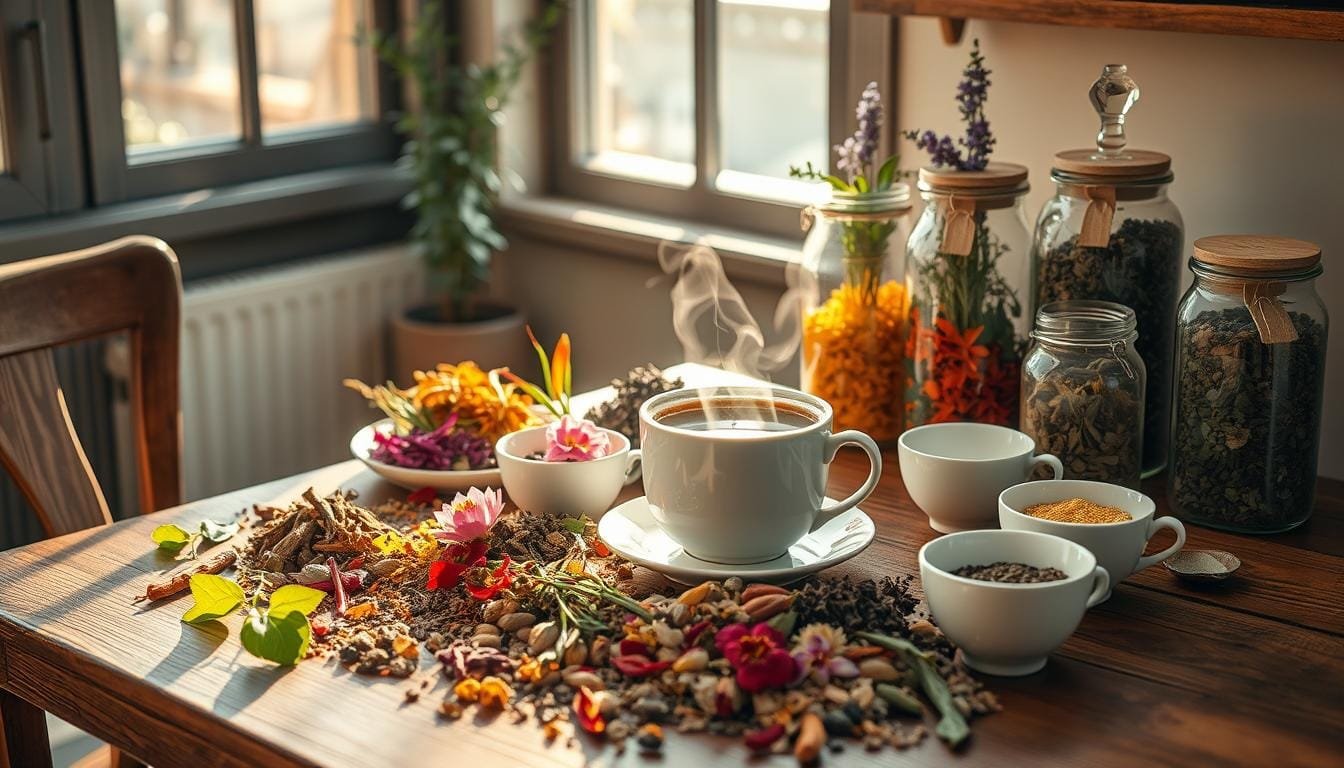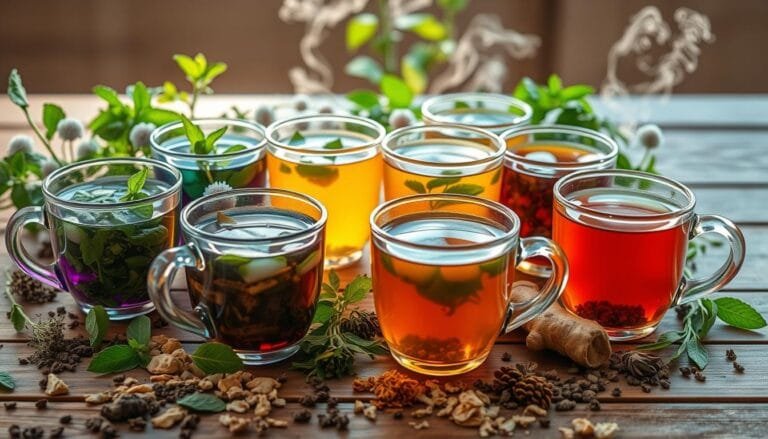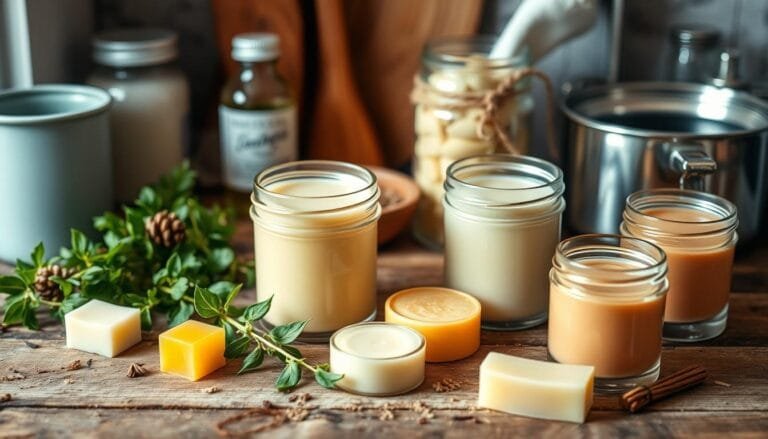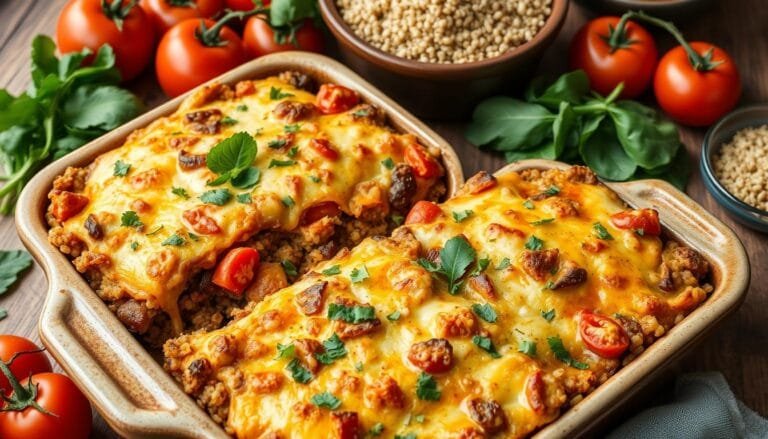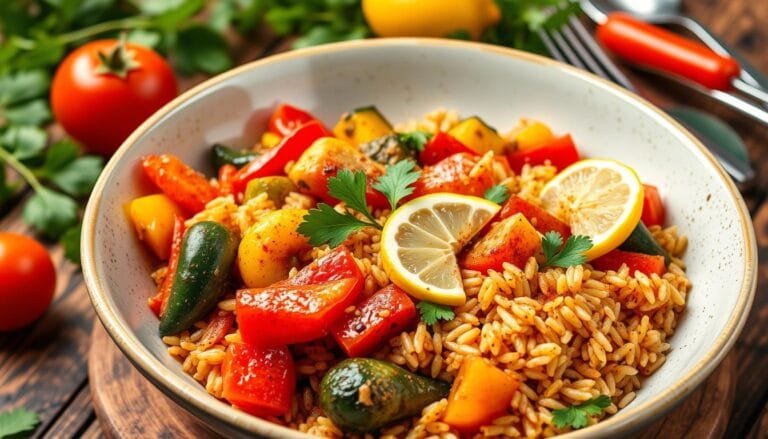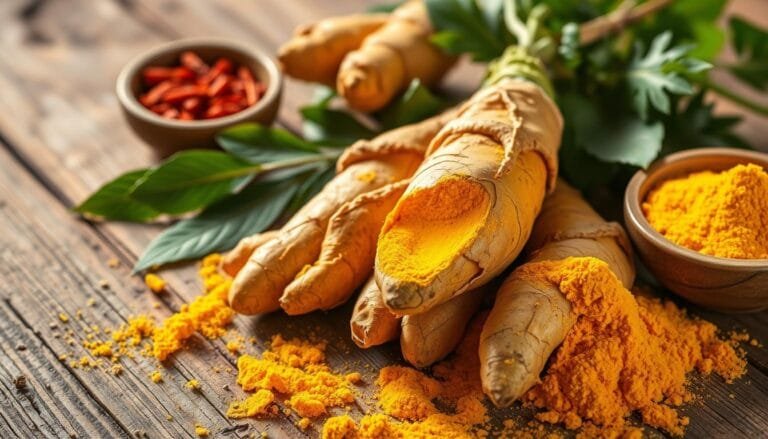I love making my own herbal tea blends. It’s fun to mix fresh herbs, flowers, and spices to create teas that are good for me. In this article, I’ll show you how to make your own herbal teas at home. We’ll talk about the benefits, share seasonal recipes, and even how to give these teas as gifts.
Making your own herbal tea blends lets you choose the flavors and health benefits you want. Whether you need a tea to relax or one to boost your immune system, you can make it. Let’s explore the world of herbal tea blending together and make our own wellness teas.
The Art and Science of Creating Tea Blends at Home
Making herbal tea blends is both an art and a science. It’s a fun journey where you can be creative and learn about blending. You’ll pick the best ingredients, use the right tools, and enjoy the health benefits of tea.
Understanding the Basic Principles of Blending
Tea blending is about picking and mixing different tea leaves, herbs, spices, and plants. Each one adds its own taste, smell, and health benefits. Knowing about base teas, supporting herbs, and accent flavors helps you make blends that taste great and meet your health needs.
Essential Equipment for Tea Blending
- Glass jars or airtight containers for storing your blends
- Measuring spoons and cups for precise ingredient ratios
- Tea strainers or infusers to ensure a smooth, sediment-free cup
- Labels or tags to identify your creations and track your blending experiments
Quality Ingredients Selection
Choosing the right ingredients is key in tea blending. Look for organic, high-quality tea leaves, herbs, spices, and dried fruits. Make sure they are free from artificial additives and preservatives. Pick each ingredient carefully to create a blend that tastes good and is healthy.
| Tea Blend | Key Ingredients | Primary Benefits |
|---|---|---|
| Chamomile Lavender Serenity Blend | Chamomile flowers, lavender buds, peppermint leaves | Promoting relaxation and alleviating stress |
| Echinacea Citrus Immunity Infusion | Echinacea root, citrus peels, ginger slices, lemongrass | Strengthening the immune system and providing antioxidants |
| Turmeric Spice Wellness Elixir | Turmeric root, cinnamon, ginger, black pepper | Offering anti-inflammatory properties and supporting joint health |
| Hibiscus Berry Radiance Infusion | Hibiscus petals, berries, rosehips, orange peel | Rich in antioxidants and supportive of skin health |
| Peppermint Eucalyptus Respiratory Blend | Peppermint leaves, eucalyptus leaves, lemon balm, licorice root | Supporting respiratory health and providing cooling, soothing effects |
By learning the basics of tea blending and choosing the best ingredients, you can create your own tea traditions. Start this exciting journey and discover the art and science of making tea blends at home.
Benefits of Making Your Own Herbal Tea Blends
Making your own herbal tea blends has many benefits. You get to choose the ingredients, ensuring they are fresh and of high quality. This makes your tea more cost-effective and wellness-focused.
Creating your own tea lets you customize the flavor and health benefits. You can tailor it to your taste and needs. This is not possible with store-bought teas.
Using fresh ingredients means your tea is not only tasty but also full of nutrients. This is different from commercial teas, which might use lower-quality ingredients or additives.
| Loose Leaf Tea vs. Bagged Tea | Loose Leaf Tea | Bagged Tea |
|---|---|---|
| Freshness | Superior freshness, as the tea leaves are intact and less exposed to air | Reduced freshness due to pre-portioning and longer storage times |
| Flavor | Richer, more complex flavor profiles | Generally less flavorful due to smaller leaf size and longer storage |
| Nutrient Content | Higher concentration of antioxidants, vitamins, and minerals | Lower nutrient levels due to the smaller surface area of the tea leaves |
| Customization | Allows for greater personalization and blending of herbs and flavors | Limited options for customization, as the blends are pre-determined |
By making your own herbal tea blends, you can improve your daily tea time. You get to enjoy customized wellness, fresh ingredients, and cost-effective tea. It’s a great way to avoid the generic taste of commercial teas.
Key Ingredients for Wellness-Focused Tea Blends
Making herbal tea blends at home is a fun and rewarding task. It’s key to know about base herbs, supporting herbs, and accent herbs. These elements help you make herbal teas that are both tasty and good for you.
Base Herbs for Foundation
Base herbs are the heart of any tea blend. They give a soothing flavor that we all love. Chamomile, peppermint, and lemon balm are popular choices. Each one has special benefits for our health.
- Chamomile: Known for its calming and anti-inflammatory effects, chamomile is a gentle base that can promote healthy sleep patterns.
- Peppermint: This refreshing herb can aid digestion, relieve nausea, and provide a mental boost.
- Lemon Balm: With its calming and uplifting citrus notes, lemon balm can help alleviate stress and anxiety.
Supporting Herbs for Function
Adding supporting herbs to your blends can make them even better. Herbs like echinacea, elderberry, and nettle are great for boosting the immune system. They help keep us healthy and feeling good.
- Echinacea: This powerful herb is known for its immune-boosting properties, making it an excellent choice for blends aimed at maintaining a healthy immune system.
- Elderberry: Rich in antioxidants, elderberry can help strengthen the body’s defenses and provide relief for common cold and flu symptoms.
- Nettle: Packed with essential vitamins and minerals, nettle can support overall health and well-being.
Accent Herbs for Flavor
To make your tea blends more interesting, add accent herbs. Herbs like citrus peels, lavender, and ginger can make your tea taste amazing. They add a special touch to your tea.
| Accent Herb | Flavor Contribution |
|---|---|
| Citrus Peels | Bright, zesty notes that can uplift and invigorate the senses. |
| Lavender | Calming, floral notes that can promote relaxation and soothe the mind. |
| Ginger | Warm, spicy undertones that can add depth and complexity to your blends. |
By mixing base, supporting, and accent herbs, you can create teas that taste great and are good for you. It’s all about finding the right balance of flavors and health benefits.
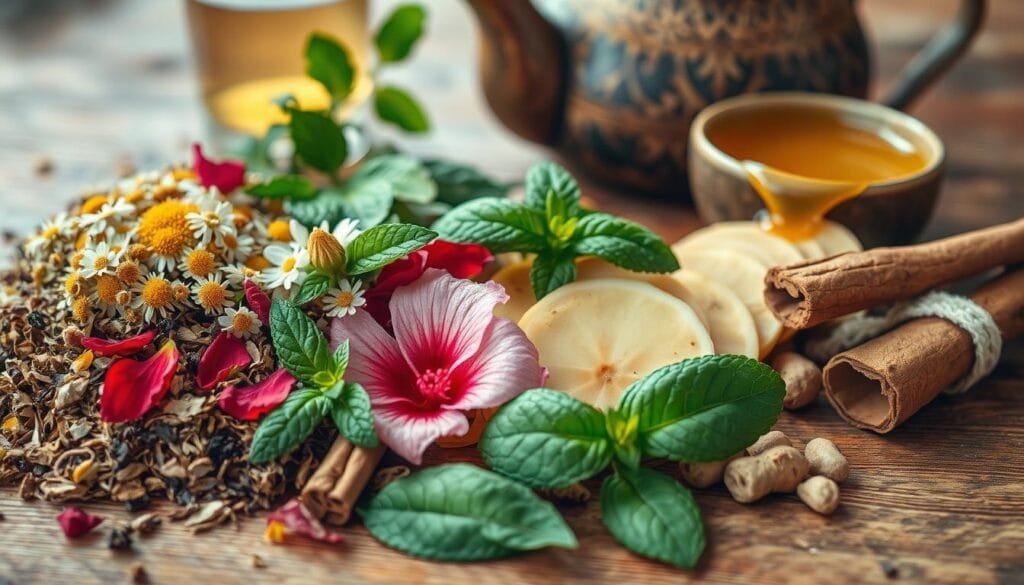
Understanding Different Flavor Profiles in Tea Blending
Making herbal tea blends is more than just mixing ingredients. It’s an art that requires knowing the subtleties of flavor profiles. As someone who loves tea, I’ve delved into the world of herbal tea flavors. I’ve learned how to mix them to create blends that are both balanced and appealing.
Herbal teas come in a variety of flavors. You might enjoy the zesty citrus of lemon verbena or the refreshing mint of peppermint. Floral notes from lavender and rose add a delicate, aromatic touch. Warm spices like cinnamon, ginger, and cardamom offer a cozy, comforting taste.
To make delicious herbal tea flavors, it’s key to mix flavors that complement each other. Bitter notes from bay leaves and licorice root can be balanced by sweet elements like honey or stevia. Sour flavors from hibiscus or lemon peel can be softened by salty components like seaweeds or herbs rich in minerals.
Exploring how different flavors work together is essential for creating balanced blends. Whether you prefer bright and refreshing or warm and comforting teas, knowing the nuances of herbal tea flavors lets you craft your own special blends.
| Flavor Profile | Characteristic Ingredients |
|---|---|
| Bitter | Bay leaves, celery seed, fenugreek seed, lavender flower, licorice root, mace, marjoram leaf, mustard seed, oregano leaf, thyme leaf, turmeric root |
| Salty | Black cohosh, cleavers, echinacea root, elecampane root, nettle leaf, plantain leaf |
| Sour | Hibiscus flower, lemon peel, lemon balm, lemon verbena, lime peel, sorrel, sumac berry, tamarind |
| Sweet | Anise seed, cardamom, cinnamon, chervil, cloves, coconut flakes, dill weed, fennel seed, hemp seeds, licorice root, meadowsweet leaf, mints, nutmeg, oat tops, poppy seeds, sesame seeds, star anise, stevia leaf |
| Umami | Basil leaf, caraway seed, fenugreek seed, garlic, mushrooms, mustard seed, nettle leaf |
| Earthy | Annato (achiote), cumin seed, oat tops, turmeric root |
| Floral | Basil leaf, coriander seed, lavender flower, lemongrass, rose petals, saffron, thyme leaf |
| Fruity | Anise seed, coriander seed, fennel seed, nigella, summer savory, star anise, tamarind |
| Nutty | Black cardamom, caraway seeds, coriander seed, cumin seed, fenugreek seed, mustard seed, poppy seed, sesame seed |
| Piney | Bay leaf, black peppercorns, rosemary leaf, thyme leaf |
| Pungent | Allspice, dill seed, epazote, garlic, ginger root, grains of paradise, licorice root, marjoram, mustard seed, paprika, spearmint leaf, star anise |
| Spicy | Bay leaf, cinnamon, cloves, coriander seed, cumin seed, ginger root, marjoram leaf, nutmeg |
| Woody | Cardamom, cinnamon, cloves, juniper berry, lavender flower, rosemary leaf, Szechuan peppercorns |
By grasping these diverse taste combinations, you can create remarkable herbal tea flavors that match your taste and wellness needs. Try mixing different ingredients, always aiming for balance and harmony for a truly enjoyable tea experience.
The Three P’s of Homemade Herbal Tea Blends
Making your own tea blends at home is rewarding. Focus on three key elements: Person, Plants, and Purpose.
Person: Considering Individual Needs
First, think about what you like and need. Do you prefer strong, earthy flavors or light, floral ones? Do you want a tea to relax you or one to wake you up? Think about your taste and health goals to make teas that feel right for you.
Plants: Selecting the Right Herbs
Look at the many herbs and choose ones that fit your health goals. Some herbs calm you down, while others boost your immune system or help with digestion. Pick herbs that work together to give you the benefits you want.
Purpose: Defining Your Blend’s Goals
Before blending, know what you want your tea to do. Do you want it to help you relax, boost your immune system, or make you feel happier? Knowing your goal helps you make the perfect tea.
Remember the Three P’s to make the most of your homemade tea. Enjoy the benefits and taste of your personalized tea blends with every sip.
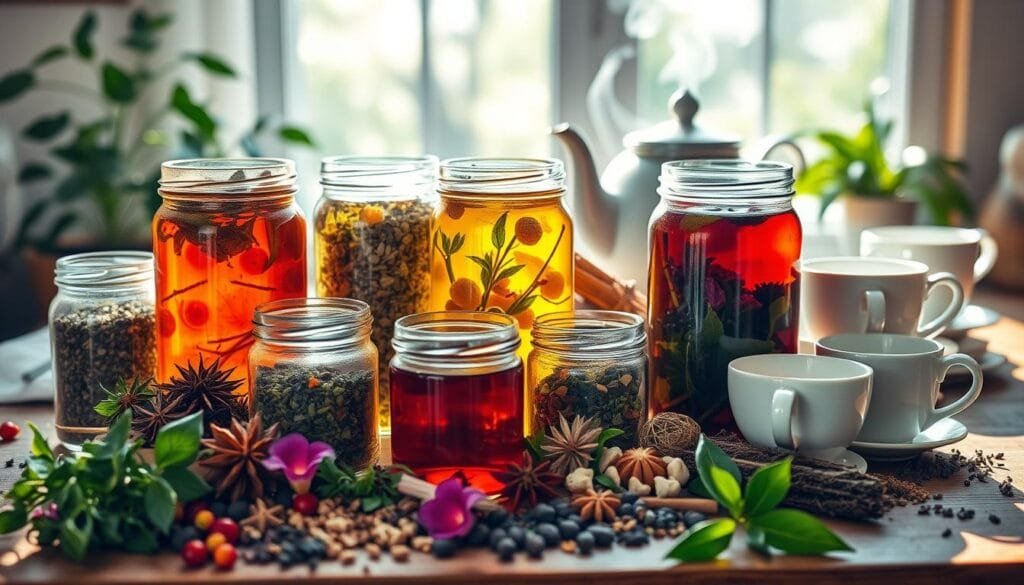
Seasonal Tea Blending: Winter Warming Recipes
Winter is here, and it’s the perfect time to make homemade winter tea blends. These teas warm our bodies and soothe our souls. They use warming herbs to make teas that help us stay well all season.
One of my favorite teas has anise hyssop, echinacea, elderberries, oatstraw, tulsi, and damiana. Each herb brings its own special benefits. Together, they make a tea that’s both tasty and good for you.
- Anise Hyssop: It tastes like licorice and soothes your breathing.
- Echinacea: It boosts your immune system and fights off winter sickness.
- Elderberries: They’re full of antioxidants and vitamin C, helping your immune system.
- Oatstraw: It calms you down and helps with stress.
- Tulsi: Also called Holy Basil, it helps your body handle stress.
- Damiana: It makes you feel happier and lifts your mood in cold weather.
To make this tea, mix equal parts of each herb together. Store it in a sealed container. To drink, steep 1-2 teaspoons in hot water for 10-15 minutes. Add honey or your favorite sweetener to taste.
| Herb | Quantity | Benefits |
|---|---|---|
| Anise Hyssop | 1 part | Respiratory support, licorice-like flavor |
| Echinacea | 1 part | Immune system support |
| Elderberries | 1 part | Antioxidant-rich, vitamin C |
| Oatstraw | 1 part | Calming, stress-relieving |
| Tulsi | 1 part | Adaptogenic, supports the body’s stress response |
| Damiana | 1 part | Mood-enhancing, uplifting |
Try this winter tea blend and let its warmth nourish you. It’s a great way to care for your body and mind during winter.
“Herbal tea is a soothing and nourishing way to support your health during the colder months. By blending together carefully selected herbs, you can create a customized wellness tonic that suits your individual needs.”
Creating Therapeutic Blends for Common Wellness Concerns
I love making my own herbal tea blends for wellness. By mixing herbs and botanicals, I make teas for different health needs. This includes relaxation, immune support, and digestive health. Let’s dive into the world of therapeutic tea blending and how to use herbs for wellness.
Calming and Relaxation Blends
For calm moments, I use herbal blends with chamomile, lavender, and lemon balm. These herbs have been calming for centuries. They help reduce stress and improve sleep. I enjoy a soothing cup of tea with these herbs before bed or when I’m anxious.
Immune-Supporting Formulations
Keeping my immune system strong is key, more so in winter. I make tea blends with echinacea, elderberry, and ginger. These powerful herbs boost immunity and fight infections. Drinking my immune tea is a natural way to support my health.
Digestive Health Combinations
Gut health is vital for wellness. I make tea blends with herbs like peppermint, fennel, and licorice root. These tried-and-true ingredients help with bloating and indigestion. The right mix of herbs improves my digestion and overall health.
Therapeutic tea blending has been rewarding for me. It lets me use herbs to support my health in a tasty way. I encourage you to try different herbal mixes and see how they can change your life.
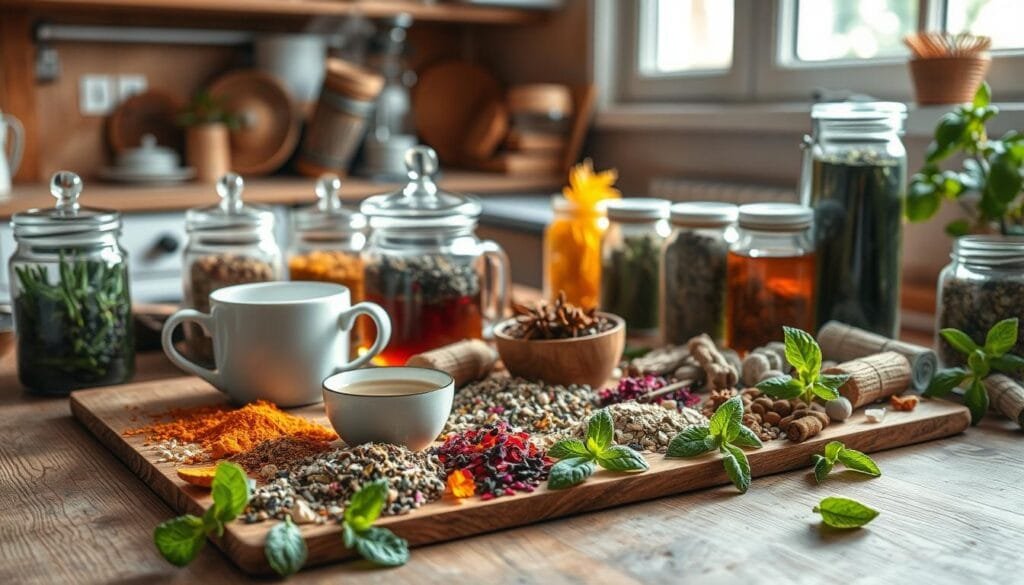
Proper Storage and Shelf Life of Tea Blends
Keeping your homemade herbal tea blends fresh is key to enjoying their health benefits. Using the right storage methods can make your teas last longer. This way, they stay flavorful and effective for months.
To keep your tea blends fresh, store them in airtight, opaque containers. Avoid direct light, heat, and moisture. Light and UV rays can quickly degrade the delicate compounds in tea. Clear glass or plastic containers are not good choices.
Tea absorbs moisture easily from the air. Keeping your blends in a dry, low-humidity environment is key to preserving their quality. Most herbal teas stay fresh for 1 to 2 years when stored properly.
After opening, tea’s freshness starts to fade. Enjoy it within 6 months to a year for the best taste. Signs of expired tea include dull, dusty botanicals, lack of aroma, and a flat or tasteless profile. If the tea doesn’t look, smell, or taste as vibrant, it’s time to replace it.
- Store tea blends in airtight, opaque containers away from light, heat, and moisture
- Unopened herbal tea can last up to 2 years, while opened tea should be used within 6-12 months
- Pay attention to visual, olfactory, and taste cues to determine if your tea has lost its freshness
By following these tea storage best practices, your homemade herbal blends will stay fresh. They will keep their longevity of herbs and preserving freshness. This way, they will deliver their full range of tea storage benefits for you and your loved ones to enjoy.
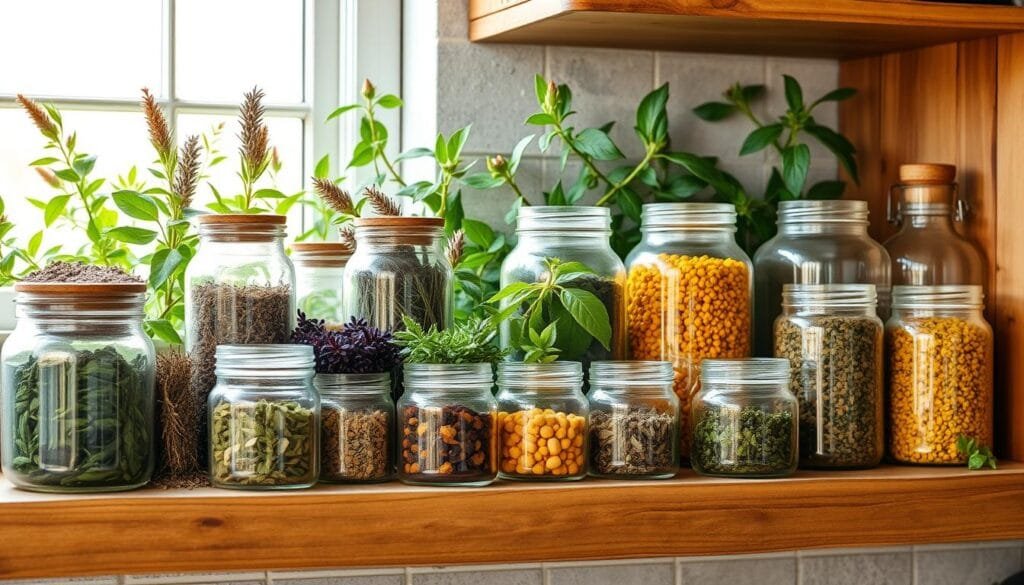
Creative Packaging Ideas for Gifting Your Tea Blends
Making your own herbal tea blends is a special process. The way you present them is just as important as the tea itself. Look into new ways to package your tea gifts that show off your creativity and care. You can use eco-friendly materials or add personal touches to make your gifts unique.
Using biodegradable packaging from recycled materials is a great idea. It’s good for the planet and shows you care about wellness and the environment. Simple tea tins can look luxurious, while designs that stand out can make your packaging a keepsake.
Adding a personal touch can make your tea gifts even more special. You could write a message, create custom labels, or draw something that shows what your tea is about. Seasonal designs can add a fun surprise for the person getting your gift. You can also use patterns or styles that match your brand.
Details matter when it comes to packaging. Make sure to include how to brew your tea and what’s in it. This way, the person enjoying your gift will appreciate the effort you put into it. Your DIY tea gifts will become something truly special and meaningful.
| Packaging Idea | Key Advantages |
|---|---|
| Biodegradable Containers | Sustainable, Eco-friendly, Conveys Wellness |
| Minimalistic Tea Tins | Luxurious, Elegant, Collectible |
| Customized Labeling | Personalized, Strengthens Brand Connection |
| Seasonal Designs | Festive, Attracts Attention, Creates Excitement |
| Geometric Patterns | Visually Captivating, Reflects Brand Identity |
By using these creative packaging ideas, you can turn your homemade herbal tea into amazing DIY tea gifts. These gifts will not only delight your loved ones but also show your love for herbal tea packaging and personalized presents.
Measuring and Steeping Guidelines for Perfect Tea
Making the perfect homemade herbal tea is more than just mixing ingredients. It’s about measuring and steeping right to bring out the best flavors and health benefits. Let’s look at the key steps to make your tea-drinking experience amazing.
Proper Ratios for Blending
When blending your own tea, the right mix is key. Start with 2 to 3 grams of blend per 6-ounce cup. This balance ensures a great taste. Try small batches to find your favorite mix.
Steeping Times and Temperatures
Tea ingredients need different steeping times and temperatures for the best taste. Here’s a basic guide:
- Green teas and greener oolong teas are best at 180°F to 170°F (30°F to 40°F below boiling).
- Black teas and herbal infusions do well in boiling water (212°F).
- Steeping times vary from 2 to 7 minutes, based on the tea or herbs.
Tea leaf size matters too. Smaller leaves infuse faster, needing shorter steeping times.
Serving Suggestions
Here are some tips to make your tea experience better:
- Use high-quality, filtered water for the best flavor.
- Warm your teapot or cup with hot water before adding tea.
- Add a lemon wedge, honey, or spices to enhance the flavor.
The art of brewing tea is about finding the right balance of measurement, temperature, and time. Try different methods to find what works best for your homemade herbal tea.
| Tea Type | Ideal Brewing Temperature | Steeping Time |
|---|---|---|
| Green Tea | 180°F – 170°F | 2-3 minutes |
| Oolong Tea | 190°F – 180°F | 3-5 minutes |
| Black Tea | 212°F | 3-5 minutes |
| Herbal Infusions | 212°F | 5-7 minutes |
By following these tips, you’ll be on your way to brewing the perfect homemade herbal tea. You’ll unlock the full flavor and health benefits of your custom blends.
Popular Herbal Combinations for Beginners
Starting your homemade herbal tea journey is exciting. Begin with classic, easy blends that taste great and offer health benefits. A favorite of mine is a mix of mint and lemon balm. Mint wakes you up, while lemon balm helps you relax, making it great for unwinding.
For better digestion, try ginger and chamomile. Ginger warms your stomach, and chamomile calms it. Steep this mix for 5-10 minutes to get the most benefits.
Looking for a tea full of antioxidants? Mix hibiscus and rosehip. Their tart, fruity taste is refreshing hot or iced. It’s also packed with vitamin C, boosting your immune system.
Once you’re comfortable with easy tea blends and herbal tea basics, explore more starter recipes. The world of homemade herbal teas is vast, full of ways to nourish your body and soul.
